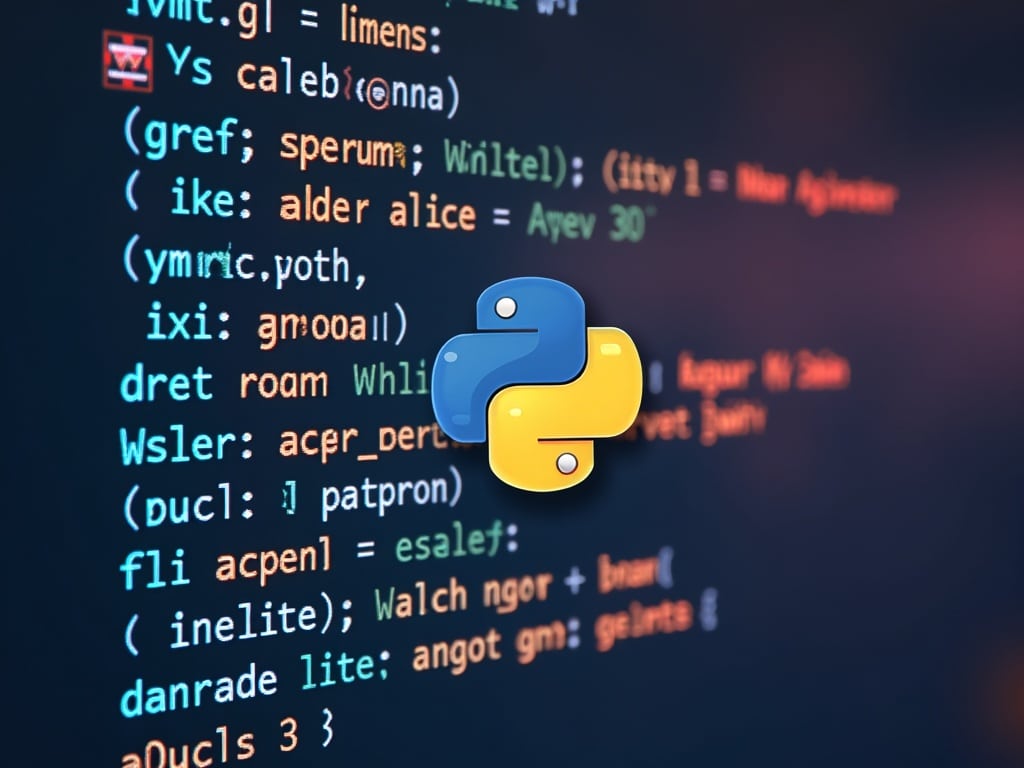Python Programming Fundamentals: A Comprehensive Guide for Beginners
Embarking on the journey of programming can feel like stepping into an unknown world filled with cryptic symbols and complex logic. But fear not! With Python, a language renowned for its readability and versatility, your path to becoming a proficient programmer becomes significantly smoother. This comprehensive guide will walk you through the essential python programming fundamentals, equipping you with the knowledge and skills to build your own applications, automate tasks, and explore the vast possibilities of the digital realm.
Why Python? Unveiling the Language’s Appeal
Before diving into the nitty-gritty, let’s understand why Python has become a favorite among both novice and experienced developers. Its key advantages include:
- Readability: Python’s syntax is designed to resemble plain English, making code easier to understand and maintain.
- Versatility: From web development and data science to machine learning and scripting, Python’s applications are incredibly diverse.
- Large Community and Extensive Libraries: Benefit from a supportive community and a vast collection of pre-built modules and libraries that simplify complex tasks.
- Cross-Platform Compatibility: Python runs seamlessly on various operating systems, including Windows, macOS, and Linux.
- Beginner-Friendly: Its gentle learning curve makes Python an ideal starting point for aspiring programmers.
Setting Up Your Python Environment
The first step to writing Python code is setting up your development environment. Here’s how:
1. Installing Python
Download the latest version of Python from the official Python website (python.org). Follow the installation instructions for your operating system, ensuring you select the option to addPython to your system’s PATH environment variable. This allows you to execute Python commands from your terminal or command prompt.
2. Choosing a Code Editor
While you could write Python code in a simple text editor, a dedicated code editor enhances your coding experience with features like syntax highlighting, code completion, and debugging tools. Popular options include:
- VS Code: A free, powerful, and highly customizable editor with excellent Python support.
- PyCharm: A dedicated Python IDE (Integrated Development Environment) offering advanced features for professional development.
- Sublime Text: A lightweight and fast editor with a wide range of plugins.
3. Running Your First Python Program
Open your chosen code editor and create a new file named hello.py. Type the following code:
print(Hello, World!)Save the file and open your terminal or command prompt. Navigate to the directory where you saved hello.py and run the program using the command:
python hello.pyIf everything is set up correctly, you should see Hello, World! printed on your screen. Congratulations, you’ve run your first Python program!
Core Python Concepts: Building Blocks of Programming
Now that you have your environment set up, let’s delve into the fundamental concepts that form the bedrock of Python programming.
1. Variables and Data Types
Variables are used to store data in your program. In Python, you don’t need to explicitly declare the type of a variable; Python infers it automatically. Common data types include:
- Integers (
int): Whole numbers (e.g., 10, -5, 0). - Floating-Point Numbers (
float): Numbers with decimal points (e.g., 3.14, -2.5). - Strings (
str): Sequences of characters (e.g., Hello, Python). Strings are immutable, meaning they cannot be changed once created. - Booleans (
bool): Represents truth values, eitherTrueorFalse. - Lists (
list): Ordered collections of items (e.g., [1, 2, apple]). Lists are mutable, meaning their elements can be changed. - Tuples (
tuple): Similar to lists, but immutable (e.g., (1, 2, apple)). - Dictionaries (
dict): Key-value pairs (e.g., {name: Alice, age: 30}).
Example:
name = Bob # String
age = 25 # Integer
height = 1.75 # Float
is_student = True # Boolean
grades = [90, 85, 95] # List
student = {name: Bob, age: 25} # Dictionary2. Operators
Operators are symbols that perform operations on variables and values. Python supports various types of operators, including:
- Arithmetic Operators:
+(addition),-(subtraction),*(multiplication),/(division),//(floor division),%(modulo),**(exponentiation). - Comparison Operators:
==(equal to),!=(not equal to),>(greater than),<(less than),>=(greater than or equal to),<=(less than or equal to). - Assignment Operators:
=(assignment),+=(add and assign),-=(subtract and assign), etc. - Logical Operators:
and(logical AND),or(logical OR),not(logical NOT).
Example:
x = 10
y = 5
print(x + y) # Output: 15
print(x > y) # Output: True
print(x % y) # Output: 0
print(x > 5 and y < 10) # Output: True3. Control Flow Statements
Control flow statements allow you to control the order in which code is executed. The core control flow statements are:
if,elif,else: These statements allow you to execute different blocks of code based on conditions.forloops: Iterate over a sequence (e.g., a list or a string).whileloops: Execute a block of code repeatedly as long as a condition is true.break: Exits the current loop.continue: Skips the current iteration and proceeds to the next.
Example:
age = 20
if age >= 18:
print(You are an adult)
else:
print(You are a minor)
for i in range(5):
print(i) # Output: 0 1 2 3 4
count = 0
while count < 3:
print(count) # Output: 0 1 2
count += 14. Functions
Functions are reusable blocks of code that perform specific tasks. They help organize your code, improve readability, and avoid repetition. Use the def keyword to define a function.
Example:
def greet(name):
This function greets the person passed in as a parameter. #Docstring
print(Hello, + name + !)
greet(Alice) # Output: Hello, Alice!5. Modules and Packages
Modules are files containing Python code that can be imported and used in other programs. Packages are collections of modules organized in directories. They extend Python's functionality significantly. Use the import statement to use modules and packages. Common built-in modules include math, random, datetime, and os.
Example:
import math
print(math.sqrt(25)) # Output: 5.0
import datetime
now = datetime.datetime.now()
print(now) # Output: Current date and time 
Working with Data Structures
Python offers several built-in data structures that allow you to organize and manipulate data efficiently.
1. Lists
Lists are ordered, mutable collections of items. They are defined using square brackets [] and can contain elements of different data types.
my_list = [1, apple, 3.14, True]
print(my_list[0]) # Output: 1 (Accessing element at index 0)
my_list.append(new item) # Adding an element to the end
my_list[1] = banana # Modifying an element
print(len(my_list)) # Output: 5 (Length of the list)2. Tuples
Tuples are ordered, immutable collections of items. They are defined using parentheses ().
my_tuple = (1, apple, 3.14)
print(my_tuple[0]) # Output: 1
#my_tuple[1] = banana # This will raise an error because tuples are immutable3. Dictionaries
Dictionaries are unordered collections of key-value pairs. Keys must be unique and immutable (e.g., strings, numbers, or tuples), while values can be of any data type. Dictionaries are defined using curly braces {}.
my_dict = {name: Alice, age: 30, city: New York}
print(my_dict[name]) # Output: Alice (Accessing value by key)
my_dict[occupation] = Engineer # Adding a new key-value pair
print(my_dict)
# Output: {'name': 'Alice', 'age': 30, 'city': 'New York', 'occupation': 'Engineer'}4. Sets
Sets are unordered collections of unique elements. They are useful for removing duplicates and performing set operations (e.g., union, intersection, difference). Sets are defined using curly braces {} or the set() constructor.
my_set = {1, 2, 3, 3, 4} # Duplicates are automatically removed
print(my_set) # Output: {1, 2, 3, 4}Object-Oriented Programming (OOP) in Python
Python is an object-oriented programming language, which means you can create objects that have both data (attributes) and behavior (methods). This allows you to structure your code in a more modular and reusable way.
1. Classes and Objects
A class is a blueprint for creating objects. It defines the attributes and methods that objects of that class will have. An object is an instance of a class. Use the class keyword to define classes.
class Dog:
def __init__(self, name, breed):
self.name = name
self.breed = breed
def bark(self):
print(Woof!)
my_dog = Dog(Buddy, Golden Retriever) # Creating an object
print(my_dog.name) # Output: Buddy
my_dog.bark() # Output: Woof!2. Inheritance
Inheritance allows you to create new classes (child classes) that inherit attributes and methods from existing classes (parent classes). This promotes code reuse and reduces redundancy.
class Animal:
def __init__(self, name):
self.name = name
def speak(self):
print(Generic animal sound)
class Cat(Animal): # Cat inherits from Animal
def speak(self):
print(Meow!)
my_cat = Cat(Whiskers)
my_cat.speak() # Output: Meow!3. Polymorphism
Polymorphism allows objects of different classes to respond to the same method call in their own way. This enhances flexibility and adaptability.
Best Practices and Further Learning
As you continue your Python journey, keep these best practices in mind:
- Write clean and readable code: Use meaningful variable names, add comments, and follow PEP 8 style guidelines.
- Practice regularly: The best way to learn programming is by writing code.
- Explore online resources: Numerous websites, tutorials, and courses are available to help you learn Python.
- Contribute to open-source projects: Gain experience and collaborate with other developers by contributing to open-source projects.
- Join the Python community: Connect with other Python developers through online forums, meetups, and conferences.
Conclusion: Your Python Adventure Awaits
Mastering python programming fundamentals is a rewarding journey that unlocks a world of possibilities. With its readability, versatility, and thriving community, Python empowers you to create innovative solutions, automate tasks, and explore the ever-evolving landscape of technology. So, embrace the challenge, dive into the code, and let your Python adventure begin!
